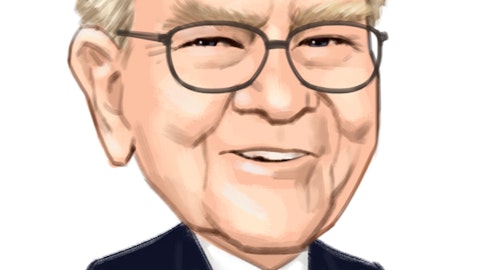In this article, we discuss the 5 best very cheap stocks to buy now according to hedge funds. To read the detailed analysis of current economic conditions and forecast, go directly to the 12 Best Very Cheap Stocks To Buy Now According To Hedge Funds.
5. AerCap Holdings N.V. (NYSE:AER)
Number of Hedge Fund Holders: 54
PE Ratio: 6.27
AerCap Holdings N.V. (NYSE:AER) is an Ireland-based aviation leasing and finance service company that has 1,700 aircraft in its fleet, including nearly 1,000 engines and more than 300 helicopters.
On November 14, AerCap Holdings N.V. (NYSE:AER) reported a major transaction of purchasing five General Electric GE90-115B engines from Mubadala Investment Company PJSC-owned Sanad.
AerCap Holdings N.V. (NYSE:AER) was covered by 6 Wall Street analysts over the previous three months, and all keep a Buy rating. The average price target of $82.67 has an upside of 23.06% as of the November 23 market close.
Horos Asset Management talked about AerCap Holdings N.V. (NYSE:AER) in its first quarter 2023 investor letter. Here is what it said:
“To explain the merits of our investments in the financial sector, I would like to end with a quick review of the difference between the management of their businesses, compared to the two risks we have just discussed, i.e., maturity mismatch and (excessive) financial leverage of traditional banking (obviously, moral hazard has no place here, as the privileges of banking do not apply to these companies). Specifically, I am going to focus on the purest cases of financial intermediation in which we are invested: AerCap Holdings N.V. (NYSE:AER), ALD Automotive, Sun Hung Kai & Co and S&U.
Let us start with maturity mismatch, which is the first of the structural problems in banking. We own a stake in AerCap and ALD Automotive, two companies with very similar businesses in their essence. In short, these entities borrow money to acquire assets (aircraft and automobiles, respectively), lease them for a period of time (on average, seven and four years) and sell them at the end of their contract (in the case of AerCap, the longer useful life of its aircraft means that the contracts are usually renewed at maturity). If these companies were to operate like a bank, they would borrow at very short maturities and would have to continually roll over that financing to avoid falling into an unsustainable liquidity risk, should they have to repay their debt (their assets are leased). However, as we have already seen, operating with such a maturity mismatch would be a recipe for failure. In fact, Guinness Peat Aviation, the company that pioneered the aircraft leasing business in the 1970s and 1980s, ended up going bankrupt (among others), for over-reliance on short-term financing.32 A lesson never to be forgotten by Aengus Kelly, CEO of AerCap and the person who inherited the unloved assets of Guinness Peat Aviation after its sale to GECAS in 1996 (by a twist of fate, Kelly eventually acquired GECAS two years ago)…” (Click here to read the full text)
Receive real-time insider trading and news alertsFollow Aercap Holdings N.v. (NYSE:AER)
Follow Aercap Holdings N.v. (NYSE:AER)
4. Lennar Corporation (NYSE:LEN)
Number of Hedge Fund Holders: 63
PE Ratio: 9.45
Lennar Corporation (NYSE:LEN) is one the biggest home construction companies in the U.S. It offers its services through various entities, including WCI Communities, Lennar Mortgage, Lennar Insurance Agency (LIA), LEN X, and more.
Over the last three months, Lennar Corporation (NYSE:LEN)’s stock was covered by 14 Wall Street analysts, and 10 of them had a Buy rating on the stock. The average price target of Lennar Corporation (NYSE:LEN)’s stock is $139.79, representing an upside of 9.70% as of November 23.
In the third quarter, 63 hedge funds held a stake in Lennar Corporation (NYSE:LEN)’s stock. Edgar Wachenheim’s Greenhaven Associates was the most prominent shareholder of the company, with 8.98 million shares worth over $1 billion.
Receive real-time insider trading and news alertsFollow Lennar Corp W (NYSE:LEN, LEN.B)
Follow Lennar Corp W (NYSE:LEN, LEN.B)
3. D.R. Horton, Inc. (NYSE:DHI)
Number of Hedge Fund Holders: 64
PE Ratio: 9.19
D.R. Horton, Inc. (NYSE:DHI) is a Texas-based home construction company that is engaged in purchasing and developing land, and constructing, and selling different types of houses and structures.
On November 8, BTIG increased the price target on D.R. Horton, Inc. (NYSE:DHI)’s stock to $178 from $164 and maintained a Buy rating. The firm believes that the company will outperform its competitors for a couple of reasons, including its position in local market share, the efficiency of its production business model, and its low-cost entry-level-home focus.
On November 7, D.R. Horton, Inc. (NYSE:DHI) posted Q4 GAAP EPS of $4.45, which beat the estimates by $0.52, while the revenue climbed 19.3% year-over-year (YoY) to $10.5 billion, surpassing the estimates by $480 million.
D.R. Horton, Inc. (NYSE:DHI) was mentioned in Baron Funds’ second quarter 2023 investor letter. Here is what it said:
“Our investments in homebuilder companies – Toll Brothers, Inc., Lennar Corporation, and D.R. Horton, Inc. (NYSE:DHI) – performed well in the first six months of 2023. The share price of Toll Brothers increased nearly 60% and the shares prices of Lennar and D.R. Horton each gained more than 35%.
Year-to-date, each company has witnessed a meaningful uptick in demand to buy homes:
Home buyers continue to come off the sidelines and buy homes despite 30-year mortgage rates remaining in the 6.5% to 7.0% range. Several factors are contributing to the recent strength, including pent-up demand to buy homes and fears that mortgage rates could move higher. • The sticker shock of rapidly rising mortgage rates appears to have cooled down. Homebuilders have made homes more affordable to prospective home purchasers by offering mortgage rate buydowns to the mid-5% mortgage rate range while maintaining strong profitability margins. • A dearth of inventory in the existing home market and an overall housing supply shortage is driving home buyers to “stretch their wallet” due to fears that they could miss the opportunity to buy a home.
We remain optimistic about the long-term potential for the Fund’s investments in Toll Brothers, Lennar, and D.R. Horton for several reasons…” (Click here to read the full text)
Receive real-time insider trading and news alertsFollow Horton D R Inc (NYSE:DHI)
Follow Horton D R Inc (NYSE:DHI)
2. Citigroup Inc. (NYSE:C)
Number of Hedge Fund Holders: 79
PE Ratio: 7.15
Citigroup Inc. (NYSE:C) is a New York-based investment banking and financial services company that offers its services in over 160 countries and jurisdictions.
On November 22, Bloomberg reported that Citigroup Inc. (NYSE:C) is considering a new direct-lending strategy to solidify its position in the expanding private credit market worth $1.6 trillion. The strategy is estimated to start by early January and would be an addition to the corporation’s syndicated leverage finance operations.
On November 2, Bloomberg reported that Citigroup Inc. (NYSE:C) was chosen, along with The Goldman Sachs Group, Inc. (NYSE:GS), to lead the initial public offering (IPO) of Ibotta, a digital marketing software firm. The listing is estimated to be valued at $2 billion and is expected to happen sometime in the next year.
Silver Beech Capital mentioned Citigroup Inc. (NYSE:C) in its third quarter 2023 investor letter. Here is what it said:
“Citigroup (“Citi”) is a large-capitalization global diversified financial services holding company that primarily serves multinational institutional and high net worth consumer clients. Citi is one of three large American banks to be designated in “bucket 3 or 4” of the “global systemically important bank” (“G-SIB”) framework by The Basel Committee on Banking Supervision. The other banks in this group are J.P. Morgan and Bank of America.
As a G-SIB, Citi is subjected to increased regulatory supervision by global bank regulators and central banks. Enhanced regulatory supervision was an important post-crisis reform to strengthen the global financial system by increasing bank capital ratios, transparency, and decreasing risk-taking. These reforms resulted in the largest G-SIBs moving away from risk-oriented banking activities such as advisory, high-yield lending, and trading, towards lower-risk activities. Indeed, Citi’s most valuable, high-growth segment, Treasury and Trade Solutions, is in lower-risk and entrenched activities such as liquidity and cash management, payments, trade solutions, and automated receivables processing. In our view, somewhat unintuitively, Citi’s increased regulatory supervision contributes to the company’s less risky banking business model, and thus its attractiveness as a downside-oriented investment opportunity.
Citi’s market perception suffers from the bank’s negative historical reputation. In 2008 during the Great Financial Crisis, Citi received the most TARP funding (the largest “bailout”) of the U.S. banks. TARP funding was provided by the U.S. government to forestall a liquidity problem that threatened to become a solvency problem. More recently, Citi mistakenly used its own capital to pay lenders when acting as Revlon’s loan agent, resulting in a $400M fine by the Federal Reserve and orders to resolve internal controls (which Citi fulfilled). Citi’s large global consumer bank was assembled by prior management in the early 2000s to attract and service high-end global consumers. Unfortunately, this pivot was costly and ill-timed in the context of increasingly complex multi-jurisdictional regulation to prevent money laundering and tax evasion. The global consumer bank has been a drag on Citi’s overall performance.
We believe the market dislikes Citi for these historical reasons and because Citi earns lower returns on equity (“ROE”) than its peers. In 2023, Citi has so far earned an ROE of ~7%, compared with peers that earn 10%+ ROEs. Recognizing that Citi is less valuable than its peers because it is a lower performance bank, we would argue that Citi’s valuation is still far too low. We believe the market is over-discounting Citi at its current valuation of ~0.48x tangible book value (“TBV”)…” (Click here to see the full text)
Receive real-time insider trading and news alertsFollow Citigroup Inc (NYSE:C)
Follow Citigroup Inc (NYSE:C)
1. Bank of America Corporation (NYSE:BAC)
Number of Hedge Fund Holders: 88
PE Ratio: 8.30
Bank of America Corporation (NYSE:BAC) is one of the largest bank and financial holding companies in the U.S. The company serves approximately 69 million consumer and small business clients and 57 million verified digital users through retail financial centers, ATMs, and digital banking.
According to Insider Monkey’s database that tracks 910 elite hedge funds, 88 funds had investments in Bank of America Corporation (NYSE:BAC)’s stock in the third quarter. Warren Buffett’s Berkshire Hathaway was the biggest shareholder in the company, with approximately 1.033 billion shares worth nearly $28.28 billion, representing 9.02% of the fund’s portfolio.
On November 6, Keefe Bruyette upgraded the rating on Bank of America Corporation (NYSE:BAC)’s stock to Market Perform from Underperform and raised the price target to $30 from $29, citing the bank’s improved productivity report and weak jobs report.
Diamond Hill Capital commented on Bank of America Corporation (NYSE:BAC) in its second-quarter 2023 investor letter. Here is what it said:
“Other bottom contributors included SunOpta, Bank of America Corporation (NYSE:BAC) and Texas Instruments. Bank of America (which we added to the portfolio in Q2) is among the US’s largest banks. Shares were pressured during the quarter against a still-challenging backdrop for banks, particularly as investors fret about rising deposit costs and the values of some longer-duration assets in a rising-rates environment.”
Receive real-time insider trading and news alertsFollow Bank Of America Corp (NYSE:BAC)
Follow Bank Of America Corp (NYSE:BAC)
You can also look at the 30 Poorest Countries In The World and the 13 Stocks Insiders are Buying Now.
Insider Monkey focuses on uncovering the best investment ideas of hedge funds and investors. Please subscribe to our daily free newsletter to get the latest investment ideas from hedge funds’ investor letters by entering your email address below.





